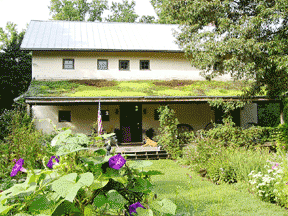Going Green Begins at Home
Straw, soil and compost are Mike Furbish’s building blocks
For a man’s house is his castle,
et domussua cuique tutissimum refugium.
–Sir Edward Coke’s Third Institute: 1644.
Yes, our house is our castle — but do we really want a castle? Aren’t they big, damp, chilly, costly to maintain with big lawns and gardens and all the rooms full of cobwebs?
We can have our castles without all their costly and time-consuming woes. Think small; think green as in green house — though not the traditional greenhouse where one tends plants and flowers.
I’m referring to green houses, houses designed to be green though not necessarily in color and certainly not of all glass. As many citizens take up arms to fight global warming, energy-efficient green houses are in vogue. The fight against global warming begins in the home, and it involves more than changing from incandescent light bulbs to the fluorescent variety and raising the thermostat in summer and lowering it in winter.
Global warming has dire consequences should we lose the fight, so this is an all-out war, in which growing numbers of citizens are becoming increasingly aware.
Snooze and we all lose.
As you take your place in this war, home is the logical place to prepare for battle. What can you do? Green your house. It might not be as costly as you fear. If it is, consequent savings can or will offset the original outlay.
This is no guarantee it will be easy. Government tells us to think green but doesn’t necessarily make it easy when it comes to permits and financing. That’s how Mike Furbish of Pasadena in North County got in to the green house business as Furbish Co. Sustainable Building of Baltimore.
Mike Furbish Builds in Straw
Mike, 50, was not a bonafide greenie. He became one when he purchased an old farm property for a residence. The farmhouse could not reasonably be converted into modern living quarters, so he started from scratch. He tore the building down and decided to build responsibly.
But bureaucracy didn’t give a green light, not to a house of straw with composting toilet and living roof. Those who issued county permits remembered it didn’t take many huffs and puffs for the wolf of Three Little Pigs fame to blow the straw house down. It took some doing before the house of straw was okayed.
Once straw became a home to the Furbishes, Mike remembered all the nitpicking in permits and the dealing with banks. Mike figured there was a demand for “something not yet available on the market.” Presto: the Furbish Co., commercial and residential.
When I questioned houses of straw, on came the sales pitch. I was quickly informed the encased straw is stacked in tightly packed bales, basically not flammable and strong as steel. No wolf could blow them down with all the huffs and puffs in the world — and they have inherent insulation equal to anything on the market. Moreover, they don’t have the phantom leaks associated with many houses, little openings that let cold or hot air in.
The living roof I like best of all. Imagine flowers and plants atop the house. They handily outdo the picturesque thatched roofs of Shakespeare’s era — though I wonder about climbing a ladder to weed and tend the garden. Usually four inches of soil is placed atop the house, enough so the plants can thrive. In summer there’s a roof akin to the colorful and legendary coat of David. It cools the house as well, and there’s all that insulation to keep the house warm.
From lawn level, neighbors and passersby can’t judge how good a gardener you are by detecting weeds amidst the drought-resistant planting. You might want to plant some tomatoes and peppers up there where the sun shines best. Adding practically to aesthetics, green roofs retain 65 percent of all rainfall, making much less runoff to the Chesapeake Bay and its tributaries. Greenery makes for green houses.
Going Green
In going all-out green, one can face the dilemma of choices. Thus far, roof solar panels have been preferred. But what happens when a house is surrounded by trees with cooling shade in summer and windbreakers in winter? Solar panels produce best in bright sunlight, so the trees have to go, which means more permits and hassles. Going green means much planning and every situation is different, Mike says.
Among the first things to be considered is the layout of the house; the long side should run east to west, better to capture the heat of the sun. And don’t overlook awnings of old for coolness in summer.
Composting toilets I’ve seen only once, in the Merrill building Chesapeake Bay Foundation calls its home in Annapolis. No flushing means less water consumed as well as less discharge headed for the Chesapeake. Not much fuss with them, Mike says; they must be emptied only a couple of times a month.
That’s much easier than in the good old days of flushless toilets, when every several years or more it was shoveling out the Chic Sales, or digging a big new hole and moving the outhouse to start all over again. There’s also the advantage of answering nature’s call in a warm house, no need to run outside barefoot in the cold of winter in a nightshirt.
Enough said.
 Volume 16, Issue 19 - May 8 - May 14, 2008
Volume 16, Issue 19 - May 8 - May 14, 2008
